Argentine Navy ww1
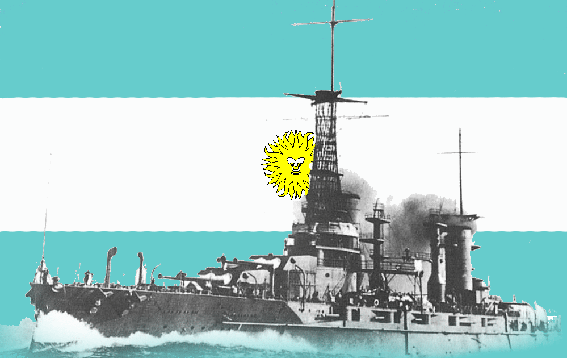
History of the Argentine Navy:
The Armada de la República Argentina was born in 1810, following the independence from Spain, on may 25, and funded by Admiral William Brown. It was preceded by an had oc one to support Manuel Belgrano in the Paraguay campaign, but sank without joining the action by ships from Montevideo. Irish-born Brown built a second one composed of international privateers as there was no budget to match yet.
Gradually it will saw action against Brazil and through the Anglo-French blockade, and grew in size when financed allowed, up to 5 armoured cruisers, 4 coastal defence ironclads, 3 second-class cruisers, 7 small cruisers and gunboats, 4 destroyers and 22 TBs in the late 1870. Before the 1907 program, the most impressive ships in the fleet has been the 6000t Italian-built Garibaldi class armoured cruisers. At that time it amounted to 600 officers and 7760 seamen, and a Marine corps. Soon, the Armada will enter the dreadnought race.
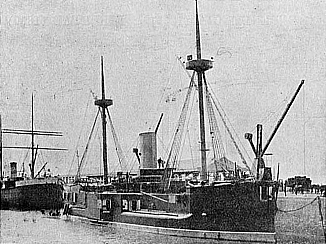 ARA Almirante Brown, 1880′ central battery Ironclad, built by Samuda Brothers of London
ARA Almirante Brown, 1880′ central battery Ironclad, built by Samuda Brothers of London
The Argentina Armada in 1914
A large fleet in 1914, it was second in tonnage for South America, ahead of Chile but behind Brazil. In 1904, an agreement for armament limitations was signed in 1904 by Brazil and Chile. In a delicate financial position, the Argentinian government saw an opportunity for a break in military spending. But this was followed by Brazil ordering two new dreadnoughts, on its way to become the main maritime force of south America.
Articles:
- ARA Buenos Aires (1895)
- ARA Garibaldi class armoured cruisers (1898)
- ARA Independencia (1958)
- ARA Nueve de Julio (1892)
- ARA Veinticinco de Mayo (1890)
- ARA Veinticinco de Mayo (1969)
- Cruiser La Argentina (1937)
- Rivadavia class Battleships
- Veinticinco de Mayo class cruisers (1930)
- WW2 Argentinian Destroyers
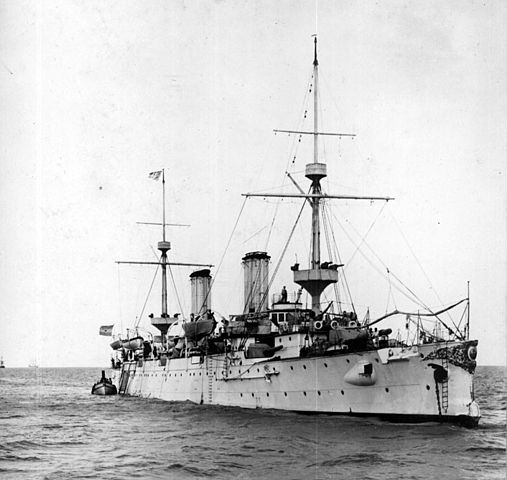
ARA Buenos Aires, Argentinian cruiser (1895)
Indeed the two new ships outclassed the entire Argentine fleet. There was an intense debate as to whether or not to engage in this new naval race in time of such financial upheaval. Border incidents with Uruguay and Brazil led later the government to decide and approve a new, scaled-up plan for the fleet.
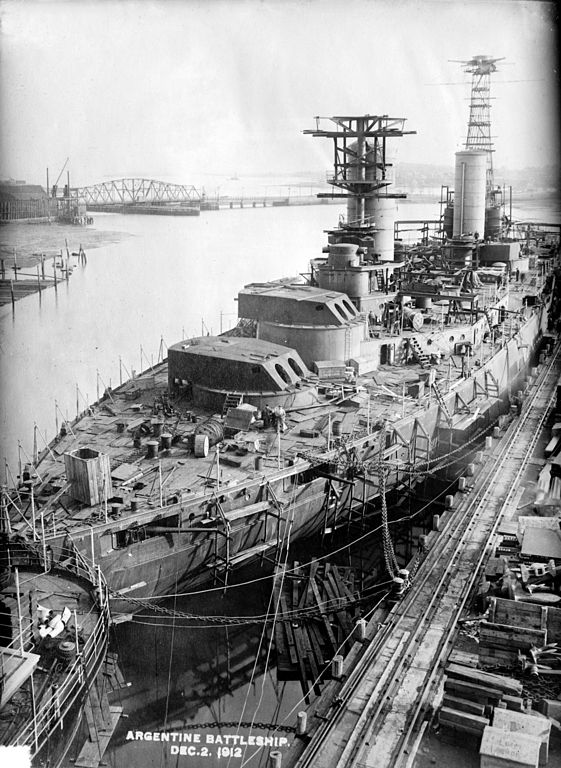
The Rivadvia in completion in 1912
Ambitious, the latter in 1907 planned two battleships built in the USA, a third remaining suspended to an additional Brazilian order, nine destroyers, and twenty-one torpedo boats. The latter, however, never arrived and were partly cacanceledue to a lack of funds.
Strength:
By size and tonnage, and to put things into perspective, the Argentinian Navy far outclassed any European Navy but France, UK, and the Central powers. It could have wrecked also any South American navy but Brazil.
7 Battleships: -2 Dreadnoughts classe Rivadavia. (Operationnal dec.1914, march 1915). Two El Plata (1874) coast guards, two Libertad (1890) class, and Almirante Brown (1880).
8 Cruisers: 4 Garibaldi class (1895), Buenos Aires (1895), 9 de julio (1892), 25 de mayo (1890), Patagonia (1885).
11 Destroyers: 4 San Luis (1911), 2 La Plata, 2 Catamarca, 3 Corrientes (1896).
13 Misc.: 2 Rosario class gunboats (1908), 2 Commodoro Py TBs (1891), 6 Bathurst type TBs (1890), TB Espero, Patria (1893) gunboat, Presidente Sarmiento (schoolship). In order: 4 classe Mendoza class DDs. Requisitioned and integrated to the Franch Navy as the Aventurier class.
Argentina in ww1
In the wake of the war, Argentina displayed a cautious neutrality, like the rest of America. The Armada remained inactive due to a lack of coal, the latter coming from English mines being reduced. Coal ships crossing the Atlantic indeed were known prey of U-boats. Three merchant ships violating territorial waters, flying the German flag, were captured. For the rest, the modest Argentinian merchant fleet was only slightly affected by the Battle of the Atlantic.
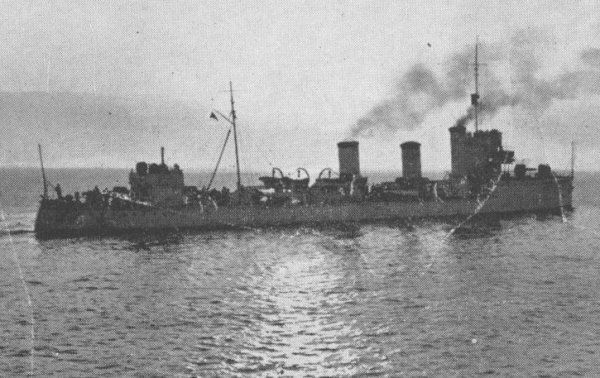
ARA Jujuy, La Plata class DDs. The Argentinian Navy did patrolled but never sank U-boats despite intense activity and three ships sunk, contrary to Brazil.
The press and Argentines in general were not in favor of a military commitment on either side. However, from April 1917 onward, an Argentinian freighter was sent to the bottom by an U-Boat, followed by two others in 1918. Despite compensation from Germany and flat apologies from the German Ambassador, diplomatic relations between the two Countries deteriorated fast.
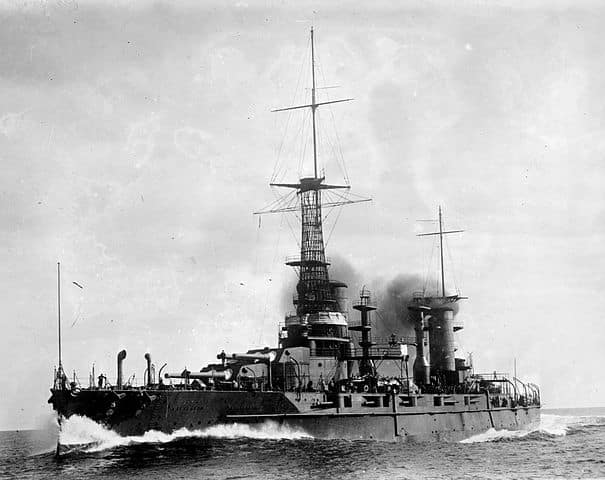
Rivadvia in trials, 1912
In Argentina itself, a German secret agent, Herr Arnold, successfully poisoned a full load of mules bound to be shipped to Mesopotamia (where Commonwealth Indian troops made extensive use of it). He did the same with grain loads, and was preparing to infect sheep and beef when finally caught in 1917. He was summarily shot by agents of the English intelligence service. But these events remained largely secret and Argentina, unlike Brazil, did not break diplomatic relations with Germany. As a result, Argentina remained neutral until the capitulation of Germany and never took part in naval operations.
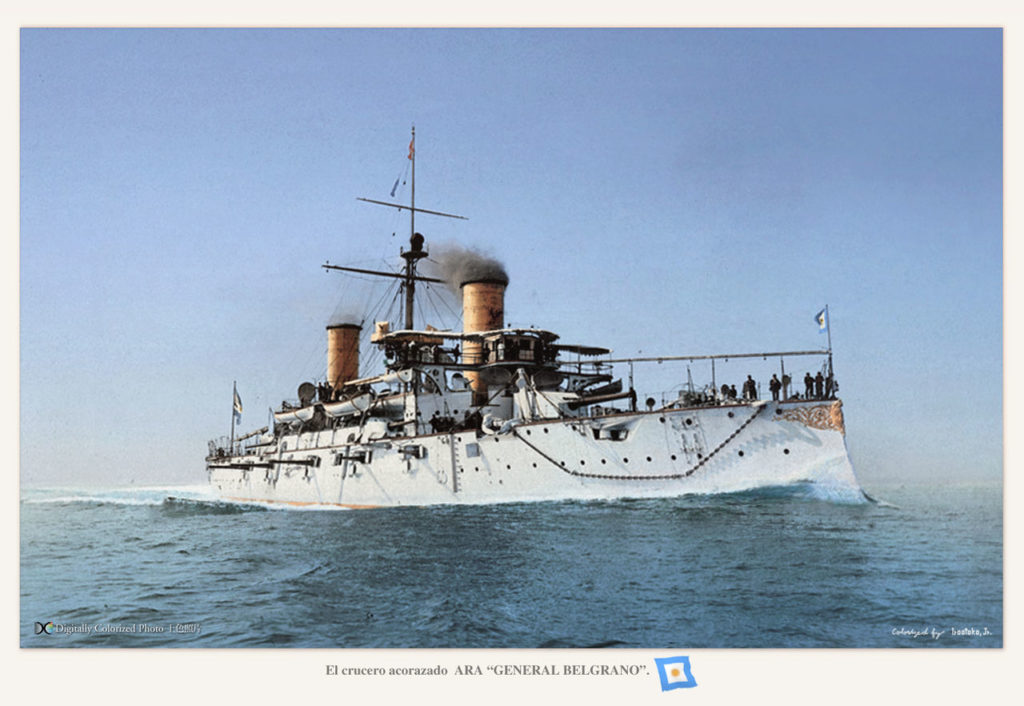
ARA General Belgrano, colorized by Hirootoko jr.
After the war
This forced neutrality leaning favorably for the Germans resurfaced in 1930 when the latter resumed spying missions in America, and again in 1945 as a haven for Nazi criminals on the run. Needless to say, he Argentinian Navy was also neutral in ww2. By 1940, the Argentine Navy was ranked as the eighth most powerful in the world, and the Rivadavia-class battleships would remains the most impressive US-built dreadnoughts ever built for export. The only test for a rejuvenated, rebuilt Argentine after ww2 was of course the Falklands, a serious test which led to political turmoil and eventually a change of regime. There will be of course one article on the Argentine Navy in ww2, another in the Cold War.
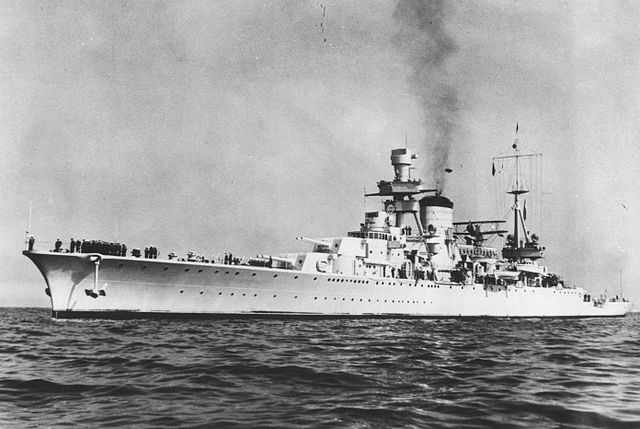
The 25 de Mayo was an Interwar Italian-built light cruiser class
Sources:
en.wikipedia.org/wiki/Argentine_Navy
en.wikipedia.org/wiki/List_of_ships_of_the_Argentine_Navy
Conways all the world’s fighting ships 1860-1905 & 1906-1921

 Latest Facebook Entry -
Latest Facebook Entry -  X(Tweeter) Naval Encyclopedia's deck archive
X(Tweeter) Naval Encyclopedia's deck archive Instagram (@navalencyc)
Instagram (@navalencyc)





 French Navy
French Navy Royal Navy
Royal Navy Russian Navy
Russian Navy Armada Espanola
Armada Espanola Austrian Navy
Austrian Navy K.u.K. Kriegsmarine
K.u.K. Kriegsmarine Dansk Marine
Dansk Marine Nautiko Hellenon
Nautiko Hellenon Koninklije Marine 1870
Koninklije Marine 1870 Marinha do Brasil
Marinha do Brasil Osmanlı Donanması
Osmanlı Donanması Marina Do Peru
Marina Do Peru Marinha do Portugal
Marinha do Portugal Regia Marina 1870
Regia Marina 1870 Nihhon Kaigun 1870
Nihhon Kaigun 1870 Preußische Marine 1870
Preußische Marine 1870 Russkiy Flot 1870
Russkiy Flot 1870 Svenska marinen
Svenska marinen Søværnet
Søværnet Union Navy
Union Navy Confederate Navy
Confederate Navy Armada de Argentina
Armada de Argentina Imperial Chinese Navy
Imperial Chinese Navy Marinha do Portugal
Marinha do Portugal Mexico
Mexico Kaiserliche Marine
Kaiserliche Marine 1898 US Navy
1898 US Navy Sovietskiy Flot
Sovietskiy Flot Royal Canadian Navy
Royal Canadian Navy Royal Australian Navy
Royal Australian Navy RNZN Fleet
RNZN Fleet Chinese Navy 1937
Chinese Navy 1937 Kriegsmarine
Kriegsmarine Chilean Navy
Chilean Navy Danish Navy
Danish Navy Finnish Navy
Finnish Navy Hellenic Navy
Hellenic Navy Polish Navy
Polish Navy Romanian Navy
Romanian Navy Turkish Navy
Turkish Navy Royal Yugoslav Navy
Royal Yugoslav Navy Royal Thai Navy
Royal Thai Navy Minor Navies
Minor Navies Albania
Albania Austria
Austria Belgium
Belgium Columbia
Columbia Costa Rica
Costa Rica Cuba
Cuba Czechoslovakia
Czechoslovakia Dominican Republic
Dominican Republic Haiti
Haiti Hungary
Hungary Honduras
Honduras Estonia
Estonia Iceland
Iceland Eire
Eire Equador
Equador Iran
Iran Iraq
Iraq Latvia
Latvia Liberia
Liberia Lithuania
Lithuania Mandchukuo
Mandchukuo Morocco
Morocco Nicaragua
Nicaragua Persia
Persia San Salvador
San Salvador Sarawak
Sarawak Uruguay
Uruguay Venezuela
Venezuela Zanzibar
Zanzibar Warsaw Pact Navies
Warsaw Pact Navies Bulgaria
Bulgaria Hungary
Hungary

 Bundesmarine
Bundesmarine Dutch Navy
Dutch Navy Hellenic Navy
Hellenic Navy Marina Militare
Marina Militare Yugoslav Navy
Yugoslav Navy Chinese Navy
Chinese Navy Indian Navy
Indian Navy Indonesian Navy
Indonesian Navy JMSDF
JMSDF North Korean Navy
North Korean Navy Pakistani Navy
Pakistani Navy Philippines Navy
Philippines Navy ROKN
ROKN Rep. of Singapore Navy
Rep. of Singapore Navy Taiwanese Navy
Taiwanese Navy IDF Navy
IDF Navy Saudi Navy
Saudi Navy Royal New Zealand Navy
Royal New Zealand Navy Egyptian Navy
Egyptian Navy South African Navy
South African Navy






























 Ukrainian Navy
Ukrainian Navy dbodesign
dbodesign